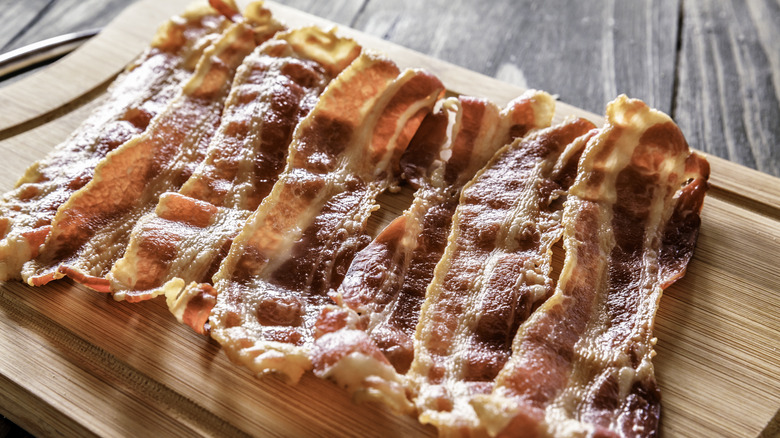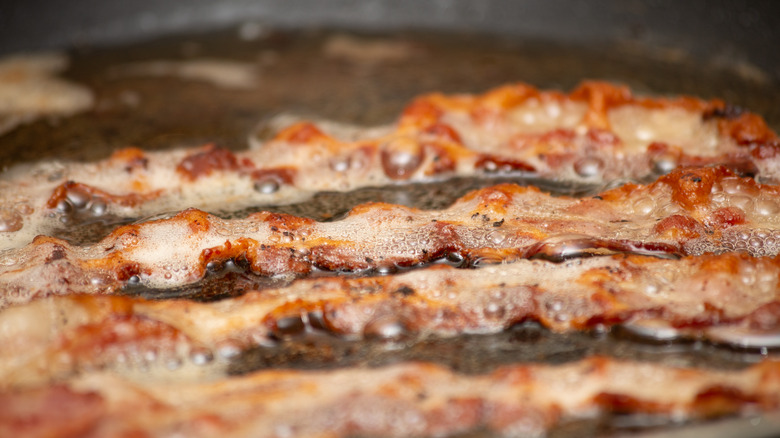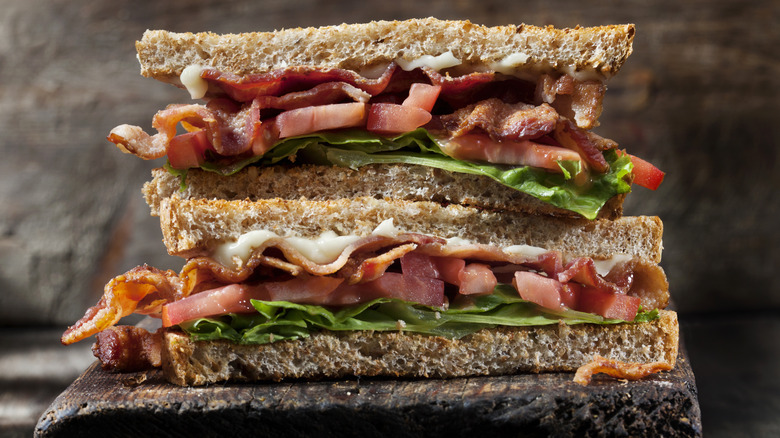The One-Step Secret To Thwarting Rubbery Bacon
How you like your bacon is a very personal decision and may change between dishes. For those who prefer this umami-flavor-bomb crispy for filling sandwiches, crumbling on salads, or accompanying eggs, here's a little-known trick to ensure you never serve rubbery bacon again. Although it may seem bizarre, the secret to the crispiest bacon is cooking it in water first.
While many different types of bacon are available, traditional pork bacon is cured and smoked, giving it its unique salty flavor. Canadian-style bacon is cut from the pork loin and is leaner, while American-style bacon is cut from the belly where roughly 90% of its weight can be fat. The meat's addictive flavor comes primarily from the fat, but it needs to be rendered to achieve the tender yet crispy texture we crave.
Starting bacon in water gently cooks the protein, giving you time to render the excess fat before the meat browns. This bacon cooking hack prevents cooking the meat too quickly, resulting in uneven doneness, leaving the ends burnt with rubbery, undercooked sections throughout. This water method works for all thicknesses, from thin strips to thick slabs, and you'll get great results — whether old-school or flavored with applewood, maple, or mesquite. Since most of the fat is rendered in water, it also cuts down on greasy splatters on the stove's surface, making cleanup easier.
How to cook bacon in water
For evenly cooked, crisp slices, start by placing the bacon in a cold pan over medium heat. Bacon's fat and protein cook at different rates. Attempting to rush the process by adding the bacon to a sizzling hot pan, as you would do when searing a steak, causes the meat to cook too quickly, not giving the fat enough time to melt.
Use a wide, heavy-bottomed pan like cast iron. It's unnecessary to use non-stick since bacon easily releases from the surface once the fat renders. Place the slices in a single layer to avoid overcrowding the pan. Add a few tablespoons of water, but don't submerge the bacon. Pouring in too much water will cause the meat to boil, drawing out some of its saltiness and increasing the cooking time. The goal is to add just enough water so that the fat has fully rendered by the time the water evaporates, roughly increasing the cooking time by only a few minutes.
Continue to cook the bacon over medium heat on both sides, flipping the slices with tongs once the first side is golden and crispy. Cooking times will vary depending on the bacon's thickness. Transfer the cooked bacon to a paper towel-lined plate to drain excess oil before enjoying.
The best ways to cook with bacon
There are several methods for cooking bacon, and the best one depends on multiple factors. When cooking for a crowd, oven-roasting bacon on parchment is the way to go, enabling you to cook a large quantity at once. Use this water method when preparing about six slices or the amount that fits in your pan in a single layer, so you don't have to cook the bacon in batches.
Bacon has a high amount of glutamate (the chemical that makes MSG so delicious), so even a small amount impacts a recipe's flavor profile. Recipes that only require a few slices per serving, like a BLT or turkey club, are ideal for the water preparation. You can prepare enough bacon for several sandwiches in a large skillet simultaneously. For a double boost of bacon flavor, use the leftover bacon grease to make an aioli to slather on the bread slices. The smoky condiment will improve any sandwich.
A few slices of perfectly cooked bacon go a long way as a salty topping for salads. Sautee a few slices to make a cobb or spinach salad, or chop up a slice (or two) to garnish your next avocado toast to add savoriness. Choose a thicker cut for chewier bacon, but keep in mind that thin bacon will be the crispiest. While the bacon drains, add cubes of bread to the same pan to create smoky croutons you'll struggle to save for the salad.



